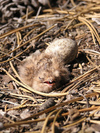Genus Chordeiles

Lesser nighthawk - The adults are dark with brown, grey and white patterning on the upperparts and breast; the long upperwings are black and show a white bar in flight. The tail is dark with white barring; the underparts are buffy with fine black horizontal streaking. The adult male has a white throat; the female has a light brown throat. This bird looks similar to the Common Nighthawk, but is slightly smaller, has a slightly less deeply forked tail, and is more buffy in coloration. The calls are also completely different. The Lesser Nighthawk has a rapid, low whistled melodious trill, lasting several seconds. It is usually heard only near breeding areas.
Antillean nighthawk - The adults are dark with brown, grey and white patterning on the upperparts and breast; the long wings are black and show a white bar in flight. The tail is dark with white barring; the underparts are white with black bars. The adult male has a white throat; the female has a light brown throat. The most distinguishing characteristic to determine its identity from its closest relative the Common Nighthawk are the contrasting pale tertials near the back of the wings of a sitting bird. There are 2 color morphs, a gray and a rufous type.
Common Nighthawk - The Common Nighthawk, Chordeiles minor, is a nightjar.
Least Nighthawk - The Least Nighthawk is a species of nightjar in the Caprimulgidae family. It is found in Argentina, Bolivia, Brazil, Colombia, Guyana, and Venezuela. Its natural habitats are dry savanna and subtropical or tropical seasonally wet or flooded lowland grassland. It is the smallest Caprimulgiformes, at 16 centimetres .

